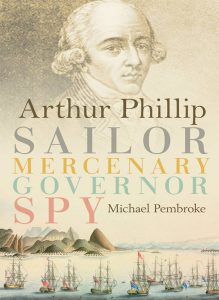- Author
- Book reviewer
- Subjects
- Book reviews, History - pre-Federation, Royal Navy, Influential People, Biographies
- Tags
-
- RAN Ships
- None noted.
- Publication
- March 2014 edition of the Naval Historical Review (all rights reserved)
Arthur Phillip: Sailor, Mercenary, Governor, Spy. By Michael Pembroke, Hardie Grant Books, Melbourne, 2013. Hardback, 354 pages, rrp $34.40
To his biography of Arthur Phillip the author adds – sailor, mercenary, governor and spy. Yes, Phillip was all of these, however not necessarily in that order. Arthur Phillip, as the first governor of the British colony in Australia, has long been a household name to us. He was governor for six years: what of the other 69 years of his life? Michael Pembroke, an author and Supreme Court Judge, has the answers in his extensive research into the life of Arthur Phillip, citing 27 pages of bibliography. He has visited the scenes of Phillip’s life from childhood in London to his death in Bath. Before Phillip’s mother married Jacob Phillip, a German language teacher, she was the widow of a seaman. Little is known of Jacob Phillip, other than he settled in London from Frankfurt. There are no extant records of his arrival in London, his marriage or death. However, he had some naval service that allowed young Arthur to attend the Charity School for Seamen in what became the Royal Naval College, Greenwich. His schooling and his mother’s naval connections saw Arthur destined for a life at sea. At age 15 he was an apprenticed seaman in a whaling ship that took him to the Barents Sea. The Seven Years War allowed him to break his apprenticeship and join HMS Buckingham as a captain’s servant when he was aged 17. He was a midshipman two years later, however promotion was slow and reaching post captain took another 24 years.
During the 18th century most officers were shunted aside on half pay in peace time. With the peace in 1763 Arthur Phillip married a wealthy widow and took up farming near Portsmouth. After six years of marriage Arthur and Charlotte agreed to live apart. At the Admiralty’s behest Phillip then spent four years in Flanders for health reasons. Pembroke’s research shows this period and a later spell in northern and southern France for health reasons were, in fact a cover for Phillip to see what was going on in France. Phillip was fluent in French and German and his language skills saw him seconded to the Portuguese navy for four years. Indeed, with the Portuguese navy he gained his first command and was in action against the Spanish. Phillip’s obituary records his commanding a convoy from Portugal to Brazil to transport 500 convicts. Pembroke has a comprehensive account of Phillip’s time with the Portuguese and argues this was never a task for Phillip. In reviewing Phillip’s selection for governorship of a proposed colony at Botany Bay, Pembroke covers the British government’s dilemma following the loss of the American colonies as a destination for excess criminals. Many destinations were considered. A colony in Botany Bay would thwart French and Spanish influence in the Pacific and also satisfy Prime Minister Pitt’s aspiration to create a global commercial network. Phillip, through his services in France and Portugal, was well known to government ministers and he was the choice of Cabinet. Lord Howe, the First Sea Lord, was not so enthusiastic.

After four years in Sydney, Phillip sought resignation because of his deteriorating health. He returned home to news of his wife’s death and the outbreak of the French Revolutionary War. Following his return to health he sought a fighting command. Whilst he was at sea in 1796-97, then aged in his late 50s, he was not in the front line. Following Napoleon’s resumption of hostilities in 1803, the threat of invasion loomed. Phillip was called to put some spine and organisation into the Hampshire Fencibles, a sort of Dad’s Army armed with what might come to hand to repel any Frenchman wading ashore. His success saw him responsible for the Fencibles throughout the country. Phillip remarried and settled in Bath, then quite the centre of fashion. His second marriage was troubled with his absences on duty, although they continued together in his retirement and gradual promotions through the ranks of admiral. Another myth Pembroke discusses surrounds Phillip’s death. Whilst he died at home in Bath, a story developed about 100 years later that he leapt to his death rather than face the agonies of his arthritis. Pembroke has sourced the background to this baseless account. He also gives coverage to Phillip’s will to dispose of his estate valued at £25,000 to relatives and friends – he had no children. Pembroke equates this amount to £40 million today, just what you would expect of a retired admiral. There is no doubt a lesser man than Arthur Phillip would not have succeeded with the establishment of the colony in New South Wales and those interested in the whole of the life of Arthur Phillip are commended to this book. The work would be improved with illustrations and maps.
Reviewed by J.W. Ellis




